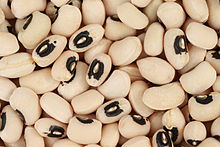Cowpea
ə
| Cow pea | |
|---|---|

| |
| Black-eyed peas | |
| Scientific classification | |
| Kingdom: | |
| (unranked): | |
| (unranked): | |
| (unranked): | |
| Order: | |
| Family: | |
| Genus: | |
| Species: | V. unguiculata
|
| Binomial name | |
| Vigna unguiculata | |
| Synonyms | |
|
Vigna sinensis | |
The cow pea (Vigna unguiculata) is one of several species of the widely cultivated genus Vigna. Four cultivated subspecies are recognised:
- Vigna unguiculata subsp. cylindrica Catjang
- Vigna unguiculata subsp. dekindtiana
- Vigna unguiculata subsp. sesquipedalis Yardlong bean
- Vigna unguiculata subsp. unguiculata Black-eyed pea
Cow peas are one of the most important food legume crops in the semi-arid tropics covering Asia, Africa, southern Europe and Central and South America. A drought-tolerant and warm-weather crop, cowpeas are well-adapted to the drier regions of the tropics, where other food legumes do not perform well. It also has the useful ability to fix atmospheric nitrogen through its root nodules, and it grows well in poor soils with more than 85% sand and with less than 0.2% organic matter and low levels of phosphorus.[1] In addition, it is shade tolerant, and therefore, compatible as an intercrop with maize, millet, sorghum, sugarcane, and cotton. This makes cowpea an important component of traditional intercropping systems, especially in the complex and elegant subsistence farming systems of the dry savannas in sub-Saharan Africa.[2] Research in Ghana found that selecting early generations of cowpea crops to increase yield is not an effective strategy. Francis Padi from the Savannah Agricultural Research Institute in Tamale, Ghana, writing in Crop Science, suggests other methods such as bulk breeding are more efficient in developing high-yield varieties.[3]

Cow peas are a common food item in the southern United States, where they are often called Black-eyed pea or field peas. Two subcategories of field peas are crowder peas, so called because they are crowded together in their pods, causing them to have squarish ends, and cream peas.
In India, in Oriya, it is called Jhudunga (ଝୁଡୁଂଗ), in Bengali, it is called Barboti Kolai, in Kannada, it is called Alasande. In Hindi, it is called lobhia or bura (when used as a string bean). In Gujarati, these are called Chola or Chowla (ચોળા). In Marathi, these are called Chawali or Chavali (चवळी). Kārāmani or Kārāmani Payir or Thatta Payir Tamil) the beans are called thatta kaai and are an integral part of the cuisine in southern region of India. In Tamilnadu during the Tamil month of Maasi (February) - Panguni (March) a cake-like dish called Kozhukattai or Adai (steamed sweet dumplings) prepared with cooked and mashed cowpeas mixed with jaggery, ghee and other ingredients. Thatta payir in sambar and pulikkuzhambu (spicy semisolid gravy in tamarind paste) is a popular dish in Tamil Nadu.
According to the USDA food database, the leaves of the cow pea plant have the highest percentage of calories from protein among vegetarian foods.[4]
Traditional cooking
In Sri Lanka, Cow peas are cooked many different ways, one way is with coconut milk.[5]
In Turkey cow peas can be consumed as appetizer being lightly boiled, covered olive oil with salt, thyme and garlic sauce. Also they are cooked with garlic and tomatoes. And they can be eaten in bean salad.[6]
References
- ^ Attention: This template ({{cite doi}}) is deprecated. To cite the publication identified by doi:10.1016/S0378-4290(03)00148-5, please use {{cite journal}} (if it was published in a bona fide academic journal, otherwise {{cite report}} with
|doi=10.1016/S0378-4290(03)00148-5instead. - ^ Blade, 2005[specify]
- ^ Scott, Christina (2008-04-10). "Sub-Saharan Africa news in brief: 25 March–9 April". SciDev.Net. Science and Development Network. Retrieved 2008-04-13.
- ^ Shaw, Monica (2007-10-28). "100 Most Protein Rich Vegetarian Foods". SmarterFitter Blog. Retrieved 2008-04-06.
- ^ "Cowpea with coconut milk". Cecilia Carvalho.
{{cite web}}: Check|archiveurl=value (help) - ^ "Cowpea with olive oil". ozlem. Retrieved 2012-01-19.
External links
- Crop Wild Relatives Gap Analysis Portal reliable information source on where and what to conserve ex-situ, regarding Vigna genepool
- Cowpea research at the International Institute of Tropical Agriculture (IITA)
- Network for Genetic Improvement of Cowpea for All (NGICA)
